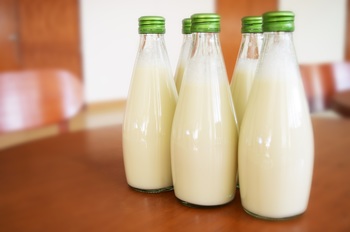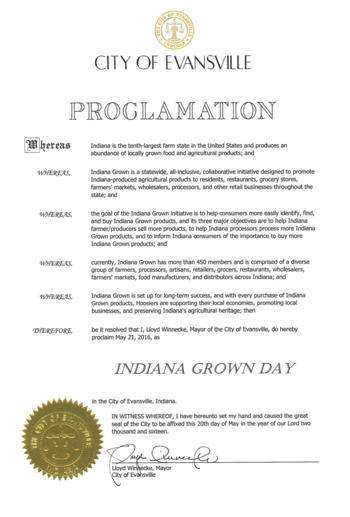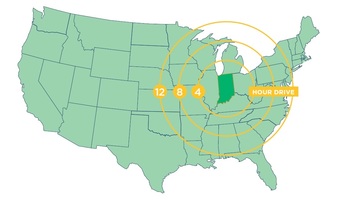|
Over a century ago, 12,000 eager
fans filled the Indianapolis Motor Speedway for the first time to watch history
in the making. As 40 of the best drivers in the nation aligned the 2.5 mile
track, the sound of their roaring engines shook the stadium – much like today.
What began as a small race on 328 acres of farmland, the Indianapolis 500 has quickly turned into the most-attended, single-day sporting event in the world.
This year, the “greatest spectacle in racing" celebrated a historic occasion: its 100th running. Not only has the 200-lap race been a unique part of our Hoosier history, drawing crowds that number in the hundreds of thousands, but there are many traditions that have been passed down from generation to generation, such as the singing of “Back Home Again in Indiana” or the traditional “milk toast” by the winner in Victory Circle.

This tradition started when Indianapolis 500 legend Louis Meyer won his first race in
1928, and upon winning his second in 1933, asked for buttermilk – his favorite
drink – to quench his thirst. Fast forward to his third win in 1936, again he asked for buttermilk; however, this time he was photographed. This spurred the
Milk Foundation to present milk to race winners on and off for the next two
decades until it became a permanent Victory Lane tradition in 1956.
Today, this tradition is sponsored by
the American Dairy Association of Indiana, which represents the 1,200 plus
dairy families in the state. This year, interestingly, it had a special,
unique connection to ISDA. Former ISDA Director and dairy farmer, Joe
Kelsay, was honored with being the Rookie Milkman and assisted Milk Woman,
Janet Dague, by handing the milk bottles to the winning driver and
their team. To make the tradition even more special, Prairie Farms donated
100,000 milk bottles so that race fans all across the stadium could participate in the largest milk toast in history.
While this was a special celebration
and continues to be a time-honored tradition for the Indianapolis 500, it also
serves as a great opportunity to showcase the importance of Indiana's dairy
farmers and the impact this vital industry has in our state.
Indiana is home to over 1,200 licensed dairy operations, helping the Hoosier state rank No. 14 in the nation in milk production and No. 2 in ice cream production. On average, Indiana has roughly 184,000 milk cows, and in March alone, Indiana’s dairy herds produced 358 million pounds of milk, according to USDA NASS. Click here to learn more about Indiana’s dairy industry or here to learn about the largest milk toast in history.
With
any new regulation it is important that government, industry, and producers
remain attuned to key benchmarks in order to be well prepared for its impact.
Congress passed, and President Obama signed, the Food Safety Modernization Act (FSMA) in 2011, which is the most substantial change to our food safety system since the 1938 Food Drug and Cosmetics Act. It shifts the focus of our food safety system as a whole to preventing food-borne illnesses rather than reacting to them. This new focus also comes with new authority to ensure compliance with prevention and risk based food safety standards. The law consists of seven rules; the last of which has been published.
The 2016 Omnibus Appropriations bill fully funded the President’s request of $104.5 million with a focus on the needs of the states in implementation. More funding will be required in subsequent years but the FY 2016 appropriation is targeted at lifting FSMA off the ground in participating states. ISDA is collaborating with the Indiana State Department of Health, Office of Indiana State Chemist and Purdue University on identifying the best way forward for the implementation of the law in Indiana.
FSMA does not change any authority over food safety that is divided by FDA and USDA, but it does allow these agencies to work more closely with the more than 3,000 state, local, and tribal government agencies that are concurrently involved in food safety. This cooperation is part of FDA’s long term aim at a National Integrated Food Safety System that will ensure quality, consistency, and effectiveness of local, state, and federal efforts to protect the food supply. The new model of food safety regulation is now prevention. It will require collaboration among the government, non-profit, and private sectors in order to adjust our state food safety systems to this new paradigm. For more information about FSMA, please click here.
On May 21, thousands of people in southwest Indiana attended the On the River Family and Farming Festival, sponsored by Indiana Grown and iPICKHERE, an online farmers market and localization hub. The festival took place at the conclusion of the Evansville River Run and featured many Indiana Grown vendors, as well as artisans, food trucks and live music.

This farming and food expo also brought in health and nutrition exhibitors, as well as gardening and farming demonstrations. There were even activities for kids provided by the Evansville Children’s Museum.

With the emphasis on health, nutrition, gardening and farming, On the River provided the perfect avenue to reach thousands of consumers in southwest Indiana to learn about Indiana Grown all while showcasing great agricultural products made by Hoosiers.
As a result of Indiana Grown's presence in Evansville, Mayor Lloyd Winnecke officially declared May 21, "Indiana Grown Day." This was the first time a city in Indiana has declared its citywide support for the Indiana Grown initiative!

Within the past couple of months, several major economic development projects have been announced that benefit Indiana and the agriculture industry.
-
Walmart announced plans to
build one of the nation’s largest milk processing operations in Fort Wayne,
creating up to 200 jobs.
-
Krone North America outlined its intentions to relocate its
headquarters from Tennessee to Shelbyville, as well as open a new facility, which would add over 100 jobs.
-
In New Castle, Boar’s
Head just cut the ribbon on a new processing facility that is expected to create up to 200 jobs in Indiana.
These announcements join many
others and support economic growth in an
industry vital to the Hoosier economy. In fact, agriculture contributes an estimated
$31.2 billion to Indiana’s gross domestic product, according to Beyond the
Farm. Last year alone, Indiana’s agricultural exports were estimated at $5.7 billion, which has tripled over the past decade. With over 57,000 farming operations in
our state, supporting 107,500 jobs, agriculture continues to be a catalyst for
economic development, and there are many reasons why.
Indiana continues to create a regulatory environment conducive to
growing the industry. From passing farmland property tax relief
legislation to repealing the Inheritance Tax, Indiana ranks second in the U.S.
for Regulatory Environment, according to Forbes. Indiana also ranks first in
the U.S. for Cost of Doing Business and eighth for overall Business Tax
Climate.

We also have many geographic advantages and a sophisticated transportation system that is crucial to growing agriculture. Indiana ranked 1st in shortest distance to median center of U.S. population and remains a national leader in pass-through interstates. Indiana is a global logistics leader and offers companies a strong competitive advantage when it comes to reaching North American and world markets. We are home to the 2nd largest FedEx air hub worldwide and 3rd in total freight railroads. With 3 international ports and 400 miles of navigable waterways, Indiana is home to the only statewide port system providing international connections for America’s Heartland via the Great Lakes and Ohio Mississippi river system.
We are also a national leader in agriculture ranking:
-
1st in commercial duck production, wood office furniture and kitchen cabinet manufacturing.
-
2nd in popcorn production, tomatoes for processing, ice cream production, total eggs produced and cropland planted with a cover crop.
-
3rd in egg layers inventory, soybeans, spearmint and fresh market cantaloupe.
-
4th in turkeys raised and peppermint.
-
5th in corn (for grain), hog production, fresh market watermelon and snap beans for processing.
While many additional factors play a role, such as our abundance of natural resources, world-class universities, and Hoosier hospitality, Indiana delivers the resources and the people that agribusinesses need to compete and win in the global marketplace. From enhancing a local-foods initiative to attracting major dairy processors, ISDA is positioned to continue to grow the industry and will build on this economic momentum to support Hoosier families.
|